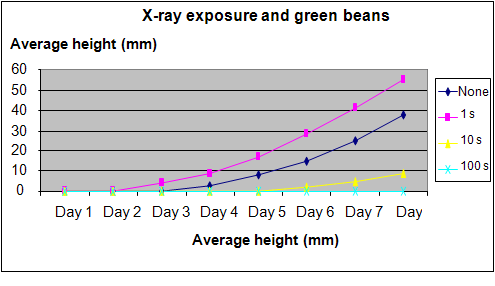| Complexity level: | 7 |
| Project cost ($): | 30 |
| Time required: | 1 hour to prepare, 8 days for the science project experiment |
| Material availability: | Easily found |
| Safety concerns: | None |
Hypothesis
Overexposure to X-rays will cause tissue damage, and prevent green beans from germinating.
Overview
Ionizing radiation
Ionizing radiation produces strong electromagnetic waves or subatomic particles that contain enough energy to ionize atoms or molecules by causing a detachment of electrons. The ionization will only occur if the electromagnetic wave or particle contains enough energy for the electron to become detached.
Sources of the ionizing radiation are radioactive materials, particle accelerators, X-ray tubes. Ionizing radiation is also present in the environment in the form of ultraviolet rays and cosmic rays. Ionizing radiation is not visible to the naked eye and is normally detected using a Geiger counter. Examples of ionizing radiation are high frequency ultraviolet rays, X-rays and gamma rays.
Ionizing radiation has found applications in fields of research, medicine, energy amongst others. However, it must be handled safely and carefully because exposure can cause damage to living tissue, radiation sickness, skin burn and even death. It has also been problem to cause cancer and genetic mutations. Ionizing radiation also affects seed germination and plant growth. Seeds that are exposed to high levels of radiation will not sprout or grow.
Scientific Terms
Materials
The materials required for this science fair project:
- X-ray machine
- 40 green beans
- 4 pots
- Sufficient soil for the 4 pots
- 1 ruler
- Water for the plants
Procedure
1. For this science project, the independent variable is the length of time during which the seeds are exposed to X-ray. The dependent variable is the height of the bean sprouts. This is determined by measuring the length of the bean sprouts with a ruler. The constants (control variables) are the type of radiation used, the type of seeds used, the amount of water and the type of soil used.
2. Permission is obtained from a a diagnostic laboratory, for the use of an X-ray machine in order to expose the green beans to X- ray radiation. The assistance of the clinic radiologist is also required, to help operate the X-ray machine.
3. The 4 pots are marked pot A, pot B, pot C and pot D before filling them with soil.
4. The 40 green beans are separated into 4 groups of 10 each. The first group of 10 beans is placed in pot A. The second group of 10 green beans are exposed to X-rays (low intensity) for 1 second and then placed in pot B. The third and fourth groups of beans are given 10 seconds and 100 seconds of exposure (at the same intensity as that given to the second group) before placing them in pots C and D
5. The pots are watered daily for the next 8 days. The number of seeds germinating in the pots and the height of the sprouts are observed. The height of each sprout in the pot is measured using the ruler. The heights of the sprouts in each pot are totaled and divided by the number of sprouts, to obtain the average height. The calculated average heights are recorded in the table given below.

Results
The green beans that were exposed to X-ray for 100 seconds did not germinate. However, the green beans that were given 1 second of X-ray exposure germinated and grew more quickly than the control beans without any radiation exposure.
|
Exposure time |
X-ray exposure, seed germination and average growth height (mm) |
|||||||
|
Day 1 |
Day 2 |
Day 3 |
Day 4 |
Day 5 |
Day 6 |
Day 7 |
Day 8 |
|
|
None |
0 |
0 |
0 |
3 |
8 |
15 |
25 |
38 |
|
1 sec |
0 |
0 |
4 |
9 |
17 |
28 |
41 |
55 |
|
10 sec |
0 |
0 |
0 |
0 |
0 |
2 |
5 |
9 |
|
100 sec |
0 |
0 |
0 |
0 |
0 |
0 |
0 |
0 |
The results of our science fair project are represented by the graph below:

Conclusion
The hypothesis that overexposure to X-rays causes tissue damage and prevent the green beans from germinating, is proven to be true.
Ionizing radiation is often used in medical applications such as radiation therapy. It is also used to sterilize tools and equipment in industrial applications. Irradiation is the process of sterilizing food with a lower dosage of radiation. The amount of radiation used is enough to kill the microbes but not enough to make food more radioactive.
Also consider
This science fair project can also be repeated to see if other plant seeds like tomato, chili or sunflower exposed to X-ray ray will germinate.
Try and repeat this science fair project by using radiation from an ultraviolet lamp.
References
The effects of radiation on plant growth development - http://www.ehow.com/how-does_5525557_effects-radiation-plant-growth-development.html
Ionizing radiation - http://en.wikipedia.org/wiki/Ionizing_radiation
How does radiation affect seed germination? - http://wiki.answers.com/Q/How_does_radiation_effect_seed_germination

